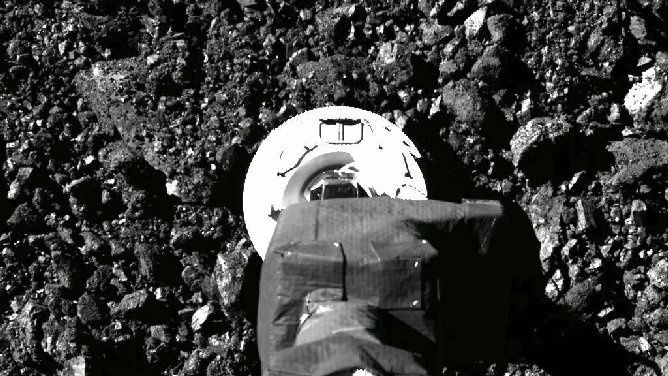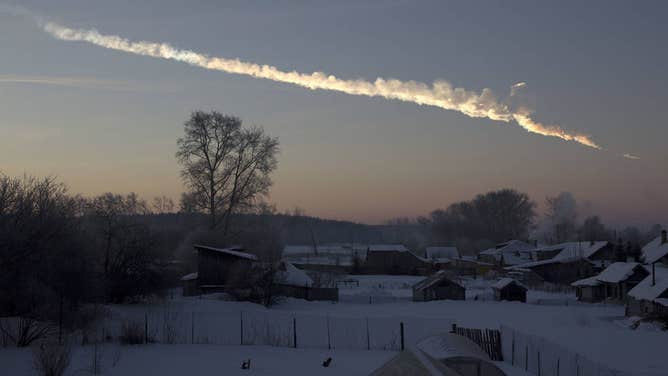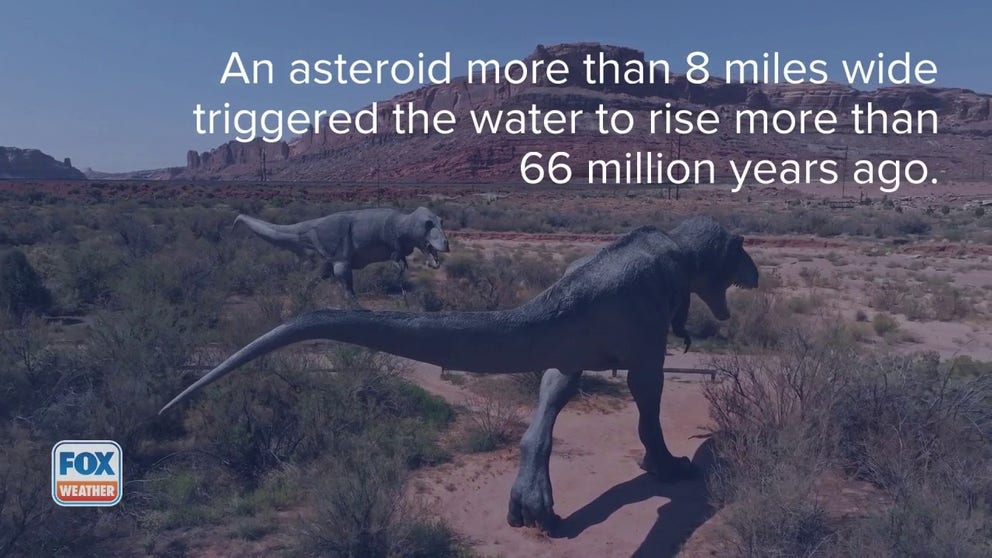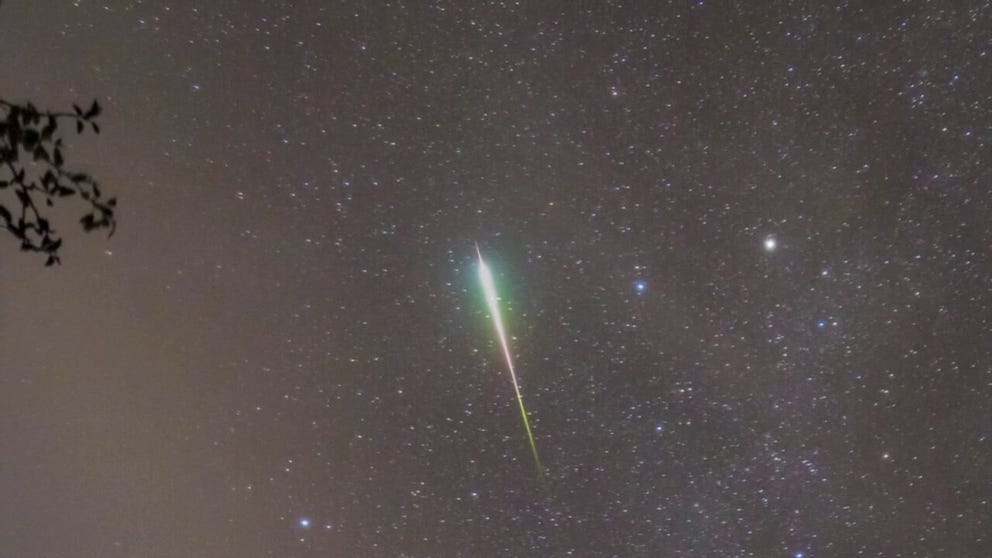Everything scientists would want to know if an asteroid was heading toward Earth
Asteroid scientist Humberto Campins explains what NASA’s Office of Planetary Defense would really look at to determine the potential impacts of a hazardous asteroid.
Dinosaur-killing asteroid triggered a tsunami with mile-high waves
An asteroid that struck Earth 66 million years triggered a megatsunami that wiped many of the dinosaurs
Small asteroids crash into Earth all the time, but what would happen in the rare occurrence that an asteroid bigger than a bus survived an encounter with Earth’s atmosphere?
An asteroid launcher simulator developed by coder Neal Agarwal aims to answer that scary albeit hypothetical question.
Agarwal, who created the simulator at neal.fun, told FOX TV Stations he was inspired by science fiction movies like "Armageddon."
"I've always wanted a tool that would let me imagine my own asteroid impact scenarios," Agarwal said. "I think the simulation can also give people an appreciation for how devastating an impact can be, and underscore why programs like NASA's DART mission are so important."
Agarwal was referring to NASA’s Double Asteroid Redirect Test (DART) when the space agency rammed a small spacecraft into an asteroid to test one method to make a small change to an asteroid's orbit if one were barreling toward Earth, and it worked.
The asteroid simulator allows you to choose the type of asteroid, speed, size and impact angle before launching it at your area of choice.
Using research studying asteroid impacts, the simulator spits out some devastating statistics, including how many people would be vaporized upon impact, the fireball radius, the shockwave and how far those impacts would travel to injure or kill people.
The results are enough to terrify anyone with even the slightest fear of asteroids
FOX Weather sent the interactive to planetary scientist and asteroid expert Humberto Campins to find out what else we would want to know about an asteroid barreling toward Earth.
'LOSS OF SIGNAL:' NASA SUCCESSFULLY CRASHES DART SPACECRAFT INTO ASTEROID FOR PLANETARY DEFENSE
Campins, with the University of Central Florida, is a scientist working on NASA’s OSIRIS-Rex mission, the spacecraft currently traveling back to Earth with the first U.S. sample collected of an asteroid. OSIRIS-Rex will drop off the sample collected from asteroid Bennu in September 2023 before heading on to study another asteroid in its extended NASA mission.
Campins said the tool reminds him of the fanfare behind the 2021 Netflix movie called "Don’t Look Up."
He said it’s always good to bring attention to planetary defense and asteroids. As fossils of our solar system, asteroids can tell us a lot about how planets formed and could be helpful to mine for future space exploration resources.
"If you want to make it available to the general public and make them aware of some of these things, it's not a bad place to start," Campins said. "If you actually want something that is going to be useful for deflecting an asteroid, it would have to be a lot more sophisticated."
Asteroids are unique

Captured on Oct. 20 during the OSIRIS-REx mission’s Touch-And-Go (TAG) sample collection event, this series of 2 images shows the SamCam imager’s field of view at the moment before and after the NASA spacecraft touched down on asteroid Bennu’s surface. (Credit: NASA/Goddard/University of Arizona)
Asteroids are made of a wide range of materials, from organic materials to metals, rocks and typically a combination of elements. If an asteroid were going to travel anywhere near Earth, scientists would first try to learn as much as possible about the material makeup of the asteroid.
"Even the metal ones are not just one element," Campins said. "(They're) usually a combination of iron, nickel and a little bit of silicate or sand."
The asteroid impact simulator offers several types of asteroids: iron, gold, stone, carbon or a comet. Campins said a gold asteroid is the most unlikely.
Carbon asteroids are the oldest or most primitive, and gold is not typically abundant in carbonaceous asteroids, according to Campins.
WHY 'ARMAGEDDON' PLOT IS NOT EARTH'S BEST DEFENSE FROM ASTEROIDS
Another thing to know about asteroids is that not all are one cohesive piece of rock. Campins said most asteroids are rubble piles.
"Only the largest asteroids are coherent, cohesive rocks," Campins said. "Anything smaller than maybe the 10 or 20 largest asteroids has gone undergone sufficient impact that they are now rubble piles held together by gravity."
Knowing the density of an asteroid would help deflect a potentially hazardous space rock because it allows scientists to understand how an asteroid will react to being hit or pushed in space.
"If it's a single rock, you send a rocket to it or some kind of device, and you push it out of its orbit, and you make sure it doesn't hit," Campins said of option A. "If it's a rubble pile, you have to know exactly how gently to push and where to push so that it, in turn, disperses because it could be that a shower of smaller asteroids is going to be just as damaging or more so than a single impact."
The asteroid's brightness can also help determine its mass because of the light it reflects.
Hitting the wall of Earth's atmosphere

This image of a vapor trail was captured about 125 miles (200 kilometers) from the Chelyabinsk meteor event, about one minute after the house-sized asteroid entered Earth’s atmosphere. (Credits: Alex Alishevskikh/NASA)
(NASA)
Another factor in Agarwal's asteroid simulator is the angle of the asteroid. Campins said this is key because if an asteroid is small enough and coming in at a shallow angle, it will explode in the upper atmosphere.
The Feb. 15, 2013, asteroid that entered the atmosphere over Chelyabinsk, Russia, broke up into small pieces at a very high altitude.
"Instead of coming directly onto the surface and hitting the ground, which in that case it wouldn't have affected as many people as it did, it happened to have exploded high up in the atmosphere where the shockwave expanded and broke windows," Campins said.
HOW TO WATCH FOX WEATHER ON TV
According to NASA, more than 1,600 were injured, primarily by broken glass, over a 200-square mile area.
Until that 2013 incident, the documented cases of asteroid-related injuries were in the single digits.
Another scenario, if the impact angle is shallow enough, is that the asteroid could bounce off Earth's atmosphere.
"If it's a kind of a very steep angle, so almost perpendicular to the Earth's surface, then it is likely to penetrate the atmosphere and not break up until it hits the ground," Campins said.
Asteroid impacts are rare
Fireball explodes as it enters Earth's atmosphere during meteor shower
A camera caught a meteor glowing brightly before it slammed into the Earth’s atmosphere during the peak of the Orionid meteor shower early on Friday.
Campins points out that an asteroid hitting a populated area or over land is unlikely. Small asteroids break up in Earth's atmosphere all the time, while some make it through the protective barrier but land in the ocean.
"We should not lose any sleep over asteroids hitting Earth because the chances of a large one hitting while we are alive are so low that it's not worth worrying about," Campins said.
"As a civilization, we must worry about that because large impacts have happened, like the one that killed the dinosaurs, and will happen again unless we do something," he added.
Some of the asteroid impacts in recent history happened in Russia – the world's largest country – including Chelyabinsk and the 1908 Tunguska meteor shockwave in Siberia.
HOW ASTRONOMERS KNEW EXACTLY WHERE A SMALL ASTEROID WOULD IMPACT EARTH
While the Chelyabinsk meteor event served as a wake-up call to international efforts to detect and stop a potential strike, an asteroid causing a shockwave equivalent to 440,000 tons of TNT is very rare.
"The chances of (it) happening over land, over a populated area and coming in at a shallow angle … all those things, that's like (a) once-every-2,000-years event," Campins said.
NASA's Planetary Defense Coordination Office and other federal agencies work with international organizations to simulate these types of asteroid threats and how humankind would respond.

